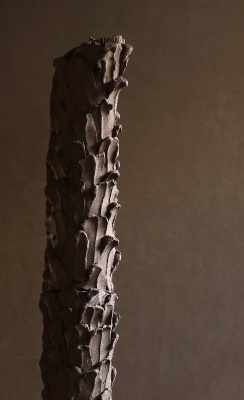Descripción de la Exposición
Censorship in art related to nudity is not a new development. Let’s just remember that in 1565 Michelangelo’s “The Last Judgment” at the Sixtine Chapel was controversial due to some naked figures. Similar reaction provoked Edouard Manet’s Olympia in 1865; perhaps topped by his colleague Gustav Corbet with his “The Origin of the World” the following year. More recently, 1989, and here in the United States, Robert Mapplethorpe’s exhibition “The Perfect Moment” scandalized many viewers to the point of being cancelled.
In this exhibition, we are exploring this kind of art censorship in Cuba through the works of two artists from distant generations: Carlos Enriquez (1900-1957), who was active from the 1930s until his death, and José Angel Toirac (b.1966) who began exhibiting in the 1980s. Both artists are using erotic images in completely different contexts and epochs. However, both suffered censorship, Enriquez couldn’t publish his book, and Toirac’s exhibition was closed this year in a gallery in Havana.toirac
Enriquez enjoyed illustrating poems and during his life did three of such projects. He was notorious for the erotic content of most of his pieces, so it is not a surprise that he was familiar with the scandalous Sonetti Lussuriosi (Aretino’s Postures or Lust Sonnets) by Pietro Aretino (1492-1556), the infamous Italian poet of the 16th century. Enriquez made explicit drawings intended to be illustrations for the book of sonnets. This project never materialized in his lifetime, the Cuban society of the 1940s was not ready for a book of this kind. However, in 2011 the book was published by Pan American Art Projects as a limited edition. It contains Enriquez’s original twelve illustrations, side by side with Aretino’s sonnets, and an introductory essay by Professor Juan Martinez. In this exhibition we are showing these drawings.
Toirac’s pieces are aiming to comment on a more complex and subtle situation in the political reality of his country. Known for his continuous testing of the waters with political issues, he is constantly finding ways of presenting his thesis in subtle ways to avoid censorship. In this instance, he was counting with the fact that viewers are not allow to touch pieces on exhibition. His solution here was to hide the real image, amateur erotic photos, on the “back” of the piece. The front sides’ shows watercolors representing objects easily recognized as Cuban, which can be part of the daily life in the island. Those could be a rum bottle, a pack of cigarettes, cigars or religious artefacts. On a first lecture this is a story about Cubans through objects that have traditionally identified the country. However, once we turn the piece, it becomes a story of any human being in the planet, who has similar desires and needs. Therefore the title of the series, which coincidentally also serves as title for the show.
According to Toirac the idea behind this series comes from the period “when the Revolution was about to celebrate its fiftieth anniversary (2009), there was a huge public scandal due to the sexual behavior of the students from the University of Informatics Sciences (UCI), who uploaded private photos on the net. This situation plus the detail that the photos circulated from hand to hand is the origin of the series.”
There is also a double meaning to the fifty anniversary, which touched the artist at a personal level. It indicates the average age of the so-called “middle life crisis” for men and the need of proving themselves. He is calling attention to the fact that it is not a geographical condition but a human one, and will equally affect people born in different lattitudes.
Nevertheless censorship in art it is not exclusive to Cuba, neither is a thing of the past, and there are many fresh examples we could mention. Recently comedian Stephen Colbert was making fun about what is consider as nudity in the media and how it is censored. Using as example a typical nude by Amadeo Modigliani (recently sold at an auction) Colbert showed the image blurred and altered, the way it was allowed to show it. Another recent example is how the very well know image of the girl burned with napalm in Vietnam taken by photographer Nick Ut in 1972, perhaps one of the most iconic images of that war and winner of a Pullitzer Prize, was taken down from Facebook for being considered as inappropriate. The rage that this incident produced was so massive that the image was restored and apologies were issued.
The questions we want to explore with this exhibition are: what is considered art and what is considered porn? Which are the indicators used to defined one or the other? Moralism or politics?

Exposición. 17 abr de 2025 - 03 sep de 2025 / Centro Cultural Andratx (CCA) / Andratx, Baleares, España

Formación. 08 may de 2025 - 17 may de 2025 / Museo Nacional Centro de Arte Reina Sofía (MNCARS) / Madrid, España